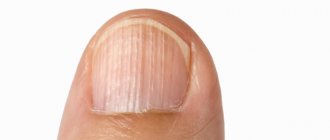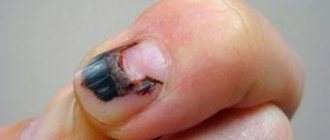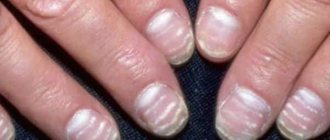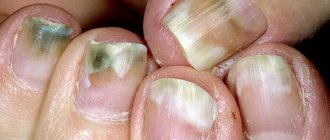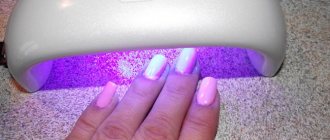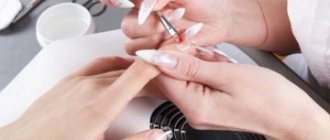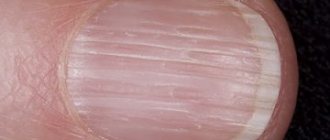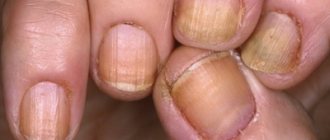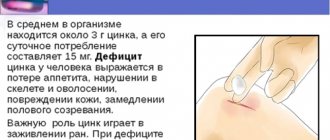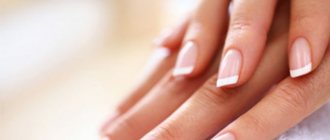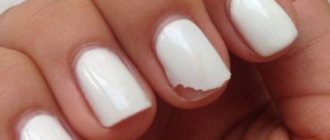The fingertips are a very sensitive part of our body, as they contain a large number of nerve endings and cells that connect the entire body. Because of this, it is important to pay attention to their condition, as well as the integrity of the protective coverings - skin, nails.
Since we do almost everything with our hands, there is always a risk of damage. One of the possible defects that girls often encounter is blueness of the nail plate or the finger itself. It is impossible to say exactly why your toenails turn blue, so it is recommended to consult a doctor and undergo diagnostics to understand the cause of the damage.
Why do nail plates turn blue?
If you notice that you have a bruised nail on your big or other toe, the sooner you determine the cause of its appearance, the sooner you can begin treatment. The reason for the appearance of blueness can be quite serious, and medical help cannot be avoided. The following explains why the nail plate on the big or other toe may turn blue:
- Trauma . If you hit the nail plate, then due to the impact and damage to the tissue, a black or blue hematoma may form on it.
- Wearing tight and uncomfortable shoes . Leads to the formation of a bruise.
- Infection . With fungal infections, blue nails often occur.
- Poor circulation . It is considered one of the first reasons for a blue fingernail. First of all, the area under the nail darkens, then the bruise can spread to the skin of the finger.
- Melanoma . This is a malignant tumor that is very rare.
Causes
A nail bruise is the same injury to a finger, only in this case there is a violation of the integrity of the blood capillaries and hemorrhage is observed in the nail bed. Most often, after such a situation, the nail is torn off. After a certain period of time, a new healthy one appears in its place.
There can be many reasons for such an injury. Basic:
- leg injury due to falling of a heavy object;
- falling on a slippery floor when the impact falls on the fingers;
- being pinched by a door;
- sports and others.
Very often the cause is careless stumbling. Usually the injury occurs due to haste.
Accompanying symptoms
Blue discoloration of the nail plate may be accompanied by the following symptoms:
- A form of cardiovascular failure. In this case, accumulation and stagnation of blood occurs in the lower extremities. The situation is very dangerous and requires special attention and urgent contact with a specialist.
- Aching pain in the nail area can be caused by mechanical damage received by a person due to improperly selected shoes, playing sports, or due to a strong blow. In these situations, the vessels begin to burst and a hematoma forms. Most often, the little finger and thumb are at risk of injury, due to their location.
- Pathological infection of the nail plate by a fungus, which can occur with low immunity.
- Damage during removal of hangnails, resulting in infection, unpleasant odor, and itching.
- Some forms of lung cancer.
- Toxic poisoning of the body, including poisoning with drugs and household chemicals that the liver could not cope with (hemochromatosis).
- Diseases of the respiratory system, asthma and bronchitis, can, in the acute phase, lead to oxygen starvation and a blue color of the plates.
Folk remedies
Traditional methods are used if, for some compelling reason, medications cannot be used. Traditional medicine is also often included in the general therapy regimen.
The most effective recipes for a bruised fingernail:
- Yarrow and plantain . When considering what to do if you bruise your fingernail, you should use these plants. Pour boiled water over the mixture of dry leaves of these plants and leave for a couple of hours. Wrap the resulting pulp in gauze and apply to the painful area. Repeat sessions twice a day.
- Badyagi mask . If the nail is blue from a bruise, then badyaga will help. This recipe fights swelling, supports the regeneration of damaged tissue, and helps to quickly cope with cyanosis under the nail plate. Dilute 30 g of badyagi powder from the pharmacy in 100 ml of warm water. Mix the mixture well and apply the resulting slurry to the nail phalanx. Wait until the product dries. The procedures are carried out 2 times a day until the soft tissues of the finger recover completely after the injury.
- Homemade ointment . If, after bruising a finger, the nail is blue, then this indicates hemorrhage and dried blood in the soft tissues of the bed. To make the hematoma resolve faster, it is possible to prepare a homemade ointment. Grate a piece of 72% laundry soap on a fine grater, add 200 ml of turpentine, 50 ml of lamp oil. Mix all the ingredients well and apply the resulting product 3-4 times a day to the injured finger for 7 days.
- Wine and vinegar . Combine both components in the same ratio and add a pinch of salt. Moisten a piece of gauze in the resulting mixture and apply to the painful area.
- Potato compress . When considering what to do if you bruise your nail, you should use a potato compress. To do this, you need small potatoes, wash them thoroughly, remove the skins, and grate them on a fine grater. Then apply the resulting paste to the painful area. Bandage the finger and secure everything with a bandage. Change the suspension twice a day. Go to bed with the gruel included.
- Onion mixture . When considering what to do if a nail is severely bruised and an abscess is noted, you should use an onion mixture. You will need to take a small onion, peel, wash and grate. Add shavings of laundry soap 72%, stir well and can be used for treatment. Apply the paste to the painful area. Perform the procedure before bedtime. This will help remove the pus as quickly as possible.
- Burdock and olive oil . When considering how to treat a bruised toenail, be sure to use burdock. Take 50 g of burdock roots, rinse them thoroughly and dry well. Take 0.2 liters of high-quality olive oil, pour over the roots and leave to steep for a day. After this time, heat the mixture a little, but it is important that it does not boil. Carefully filter the composition and can be used for treatment. Apply the ointment to the painful area a couple of times a day.
- Salt baths . This folk remedy is extremely popular and effective in preventing infection of soft tissues injured by the nail. If you hurt your finger or your nail is blue, then take 2 liters of warm water for a bath, add a large spoonful of salt, the same amount of baking soda and a small spoonful of iodine. Mix everything thoroughly and place the injured leg or arm in the bath. After a quarter of an hour, remove the limb and wipe it dry. Afterwards treat the injured finger with peroxide. After the limb has been steamed, apply healing ointment.
- Horsetail and birch buds . When considering how to relieve pain from a bruised nail, you can make a compress from the listed plants. Take 1 small spoon each of birch and horsetail buds, mix and pour a glass of boiling water. Let the composition brew thoroughly. Take a piece of gauze, soak it in the resulting product and apply it to the damaged nail. Be sure to secure the bandage with a bandage. Apply such compresses a couple of times a day until the unpleasant symptoms go away.
- Fresh sour cream . When considering what to do if your nail turns blue from a bruise and the pain does not subside, you should use fresh sour cream. The painful area must be generously lubricated with a dairy product and left for a quarter of an hour. Repeat sessions until pain and swelling are eliminated.
- Cabbage leaf or aloe . Paying attention to the question of how to relieve pain from a bruised nail, you can use fresh cabbage leaves or aloe. First mash the leaf and cut the aloe. Change compresses every 3 hours. If there is no fracture, then the swelling and pain will go away quickly.
These are just the basic effective recipes that will help with a bruised nail. But only a doctor can tell you exactly what to do if your toenail is severely bruised.
When to see a doctor?
If the injury is minor and the nail has slightly changed its color, then it is not necessary to contact a specialist. Over time, he will rehabilitate himself. If there is no unpleasant odor and the nail plate does not hurt, it is recommended to disinfect the nail plate every day.
If the injury is more serious, the nail turns blue, which is accompanied by pain and discomfort, then in this case you should contact a specialist immediately; the sooner the cause of the appearance of dark spots is determined, the more effective the treatment will be. A quick and correct diagnosis will help speed up recovery.
Classification of bruise by severity
Depending on the strength of the impact, several degrees of severity of damage are determined. If a nail bruise occurs due to a bruised finger, then consider:
- Mild degree . The nail plate is not seriously injured. The pain usually goes away within the first minutes after the injury. The nail may pulsate a little, but there are no obvious changes. Also in this case there will be no cyanosis.
- Average degree . The integrity of the soft tissues does not change much; the nail is injured. This is often observed when a toenail is injured, for example, when children play football. The nail may peel off slightly on the sides. In this case, it is recommended to cut off the peeled nail immediately. Treat damaged soft tissues with an antiseptic or lubricate them with brilliant green.
- Severe degree . If the nail bruise is severe, then the nail is blue. Literally before the victim’s eyes, the shade changes from light pink to dark blue. This occurs due to the penetration of blood into the bed. The integrity of the nail can also be changed beyond the boundaries of contact with soft tissues.
- Very severe . This problem occurs with complex mechanical injuries. According to statistics, damage to the plates on the upper extremities is much more common. Usually this is when your fingers get caught in the mechanism. The nail itself receives severe destructive damage, its integrity can be completely damaged. Usually, problems are observed not only with the plate itself, but also soft tissues are affected, open wounds appear, a finger may be dislocated or cracks may be noted.
Determining the degree of severity determines what to do in case of a severe bruise of the fingernail.
Treatment
If, upon examination by a specialist, no abnormalities in the functioning of the body were detected, then treatment can be carried out at home. In this case, both medications and folk remedies are provided:
- In case of injury or bruise, it is recommended to use ice or any other cooled product that can reduce the formation of bruises in the event of a bruise. If the pain is severe, you can use painkillers or ointments. For bruises, an elastic bandage is also used.
- If the nail is damaged due to cosmetics, you must wait for the natural color change of the nail, and also be careful with low-quality decorative cosmetics.
- If the extremities are frostbitten, it is necessary to urgently begin warming measures, these could be: warm baths, rubbing with warming agents.
- When wearing tight and uncomfortable shoes, blood flow may decrease, which can cause bruising. In order to increase blood flow, it is recommended to take a foot bath with sea salt; this procedure should last at least 20 minutes. You can also add aroma oils to the bath and perform a restorative foot massage using this oil.
- During periods of elevated temperature, the extremities of the legs and arms become cold, as a result of which the nails turn blue. This is due to spasm of blood vessels, which can disrupt the body’s heat exchange during high temperatures. In such a situation, first of all, you should take a tablet, for example, No-Shpu, the dosage is recommended to be determined by age category. Afterwards, start rubbing your arms and legs in order to disperse the blood through the veins, and add a warm, generous drink.
- Vitamin complex. Many experts advise taking it for general strengthening of the nail plate.
Unfortunately, in most cases, blue nails can be caused by serious problems in the body.
How to determine nail damage
No one has the ability to protect themselves from injuries to their fingers. It is very important to know in general what treatment should be for a bruised thumbnail. Before starting the sessions, it is necessary to determine whether the bruise is actually received.
There are a number of signs by which you can identify a bruised nail.
- A strong and sharp mechanical impact on the nail is always accompanied by the appearance of bruises. For this reason, when a bruise occurs, the nail is blue. Sometimes even a black tint appears. But the plate itself retains its shade, and the darkening is noted due to the blood accumulated under the plate.
- Within two days the nail begins to turn yellow. This indicates that the cells are beginning to die. The person will feel pain all the time until the bruise disappears. At first it will be intense, aching, and then sharp, appearing only when the nail comes into contact with a hard surface. The finger quite often becomes swollen and the dermis turns red.
- Quite often, an injury to the thumbnail is accompanied by a fracture of the phalanx. With such a problem, it is very important to determine the presence or absence of bone tissue damage. In this case, the soft tissues swell very much, and any movement causes severe pain.
The symptoms of a plate injury are always identical, which helps to accurately identify the type of injury.
Outcome of the problem in the absence of treatment
If the nail plate is left untreated, its recovery can take a long time and lead to serious problems. Lack of treatment can lead to serious consequences, such as:
- nail deformation;
- limitation of motor function;
- swelling;
- the presence of purulent discharge;
- specific smell;
- shooting and aching pain.
If the pathology provokes the appearance of a fungus, self-medication is contraindicated; in this case, only a specialist can help.
The doctor must prescribe the necessary procedures, medications and wellness manicure. In order to speed up the healing process of the nail, it is necessary to include in the diet foods that contain large amounts of calcium, and periodically take baths with salt. These procedures will help normalize the pressure in the area of the diseased area, and the blood will gradually begin to flow out of the nail plate.
First aid
If a severe bruise of a fingernail occurs, then first aid is indicated for the following purposes:
- reduce the level of pain;
- slow down the process of hematoma formation and try to prevent convergence;
- prevent infection from penetrating under the nail plate.
The following assistance is provided to the patient right on the spot:
- apply a cold compress to the sore finger;
- the limb with the sore finger is raised a little higher to slow down the blood flow;
- be sure to treat the nail with an antiseptic (use hydrogen peroxide or alcohol);
- bandage the finger, massaging, but under no circumstances use warm applications;
- if the nail is torn off and comes off, it should be attached with a band-aid;
- if the free edge is long enough, then trim it;
- remove the rings from your fingers, as with such an injury your fingers may swell.
If you have bruised your toenail, do not put on shoes and, if possible, do not move.
What to do for prevention?
The best cure for a disease is prevention . In order not to encounter various diseases of the nail plate and prevent the appearance of dark spots, it is recommended to adhere to the following rules:
- Choose high-quality and comfortable shoes made from natural materials.
- It should not squeeze or cause discomfort when worn.
- When processing your nails, be careful not to damage the cuticle; it is recommended to trim it very carefully and not too much.
- When using varnishes, you should pay attention that they do not contain aggressive impurities.
- Hygiene. Keep your feet clean and dry.
- Regular airing of shoes.
- Avoid frostbite. If your feet become hypothermic, you should immediately warm them up.
Blue nails are not considered an independent disease. In most cases, it manifests itself as a cause indicating a problem in the body.
Giving the nail an aesthetic appearance
When considering how to treat a bruised nail and what to do in this situation, it is equally important to give the nail an aesthetic appearance. If a hematoma or blood stains are visible through the nail, the manicurist sees traces of a bruise on the nail plate. In a salon environment, it is possible to give the plate a normal appearance and hide all flaws. If the bruise is not severe, then it is enough to cover your nails with a dark shade of varnish.
Using gel polish will hide the nail for 4-5 weeks. The structure of the coating consists of special plasticity. Gel polish does not affect nail formation and growth. It is also possible to use sculptural bio-gel. This coating not only does not peel off within 3-5 weeks, but also supports moisture exchange to a significant extent. If the bruise of the nail is not large, then you can use manicure oils.
It is important to know
Even if there is no fracture, it would be a good idea to consult a doctor. If a severe hematoma forms, it is necessary to perform a minor surgical intervention and, using a thin, sharp, sterile object, make a small hole in the nail plate and thus release the accumulated blood. Often, such manipulation helps protect the nail from rejection and significantly improves the healing process.
We recommend: I pinched my nail and it turned black: what to do?
In the event that going to the doctor for some reason is impossible, and the resulting bruise under the nail hurts unbearably, you can carry out a similar procedure yourself, only for this you must strictly follow the rules of hygiene. First, you need to wash your hands and treat the bruised nail with any antiseptic, then heat a regular sewing needle over a fire and carefully make the desired hole with it, release the blood and treat the nail again with iodine or peroxide to avoid infection.

